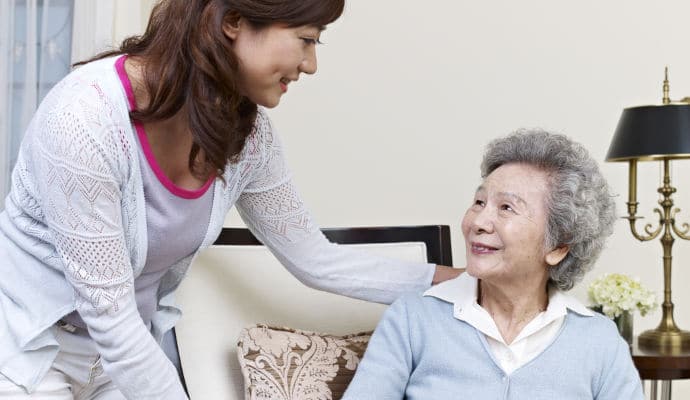
You want to know that your older adult is well-cared-for
When you hire an in-home caregiver to help care for your older adult, it’s natural to worry.
You want to know that they’re being treated with kindness and that all their needs are met.
To help you find out how things are going, we share 5 simple ways to discreetly check on their hired caregiver.
When you know the caregiver is getting along well with your older adult and is keeping them healthy and safe, you’ll have greater peace of mind.
These 5 ways to check on your older adult’s in-home caregiver are simple, practical, and help reduce caregiver guilt and stress.
1. Stay in touch by unexpectedly dropping in or calling
The simplest way to check up on your older adult’s in-home caregiver is to drop by unannounced for brief visits.
It’s wise to make this a habit, not just do it in the first few weeks after they were hired. That sends the message that you’re continuing to keep a close eye on your older adult’s care.
While you’re there, look for signs that tell you how they’ve been spending their time.
Is your older adult clean, fed, and in good spirits? Is the caregiver engaging them in conversation or an activity? Or is your older adult asleep in front of the TV with the caregiver focused on their smartphone?
Visiting in person is best, but if you aren’t able to drop by, call your older adult instead. Ask a few questions about what’s been happening to get a feel for how the day is going.
If talking to your older adult isn’t possible, it’s still worthwhile to call and chat with the caregiver.
2. Trust your gut instincts
You’ve probably heard this a million times: trust your gut. If something feels wrong, investigate further. Don’t dismiss your uneasiness as nothing or paranoia.
A wrong feeling is a good enough reason to let someone go or to not hire them. Your older adult’s well-being isn’t worth the risk.
3. Ask for and listen to your senior’s feedback
Your older adult is an important source of information. Have casual conversations about how they feel things are going with the in-home caregiver.
Listen openly and without judgement so they’ll be more likely to confide in you.
Even with older adults who might complain because they don’t want to have a caregiver around, you’ll likely be able to tell the difference between regular complaints or signs of problems.
If anything they say sounds odd or suspicious, take it seriously and investigate further.
4. Ask for a daily log
Ask the caregiver to write a daily journal that briefly documents how they spent the day.
This should include notes about your older adult’s mood, appetite, medications, and bathroom visits.
They can also make notes of any problems, injuries, or questions for you.
5. Recruit neighbors to help keep an eye on things
If your older adult has kind neighbors that you trust, ask them to keep an eye out for any strange activity.
Or, after introducing them to the caregiver as a trusted friend, ask them to drop in once in a while to see how things are going.
Recommended for you:
- 3 Tips to Get Peace of Mind When Using an In Home Caregiver
- How to Hire a Driver for Seniors: 6 Tips
- This Guide Helps You Make a Caregiving Plan in 5 Steps
By DailyCaring Editorial Team
About the Author

Connie is the founder of DailyCaring.com and was a hands-on caregiver for her grandmother for 20 years. (Grandma made it to 101 years old!) She knows how challenging, overwhelming, and all-consuming caring for an older adult can be. She also understands the importance of support, especially in the form of practical solutions, valuable resources, and self-care tips.













I wish I would d have never convinced my mother to go to a level. 2 care home. She expressed things that were not right and died 2 months later having had 3 to. 4bdays missing antibiotics. Also was found outside crying by a visitor. As all families I was so scared to speak up. I still have not and my mother is dead.
We’re so sorry for your loss. You made a very tough decision with the information that you had at the time.
If it would help bring some closure, you may want to contact the care home licensing organization in your area of Canada to file a complaint.
You may also find it helpful to speak with a therapist, counselor, or faith leader to get assistance with processing these challenging feelings.